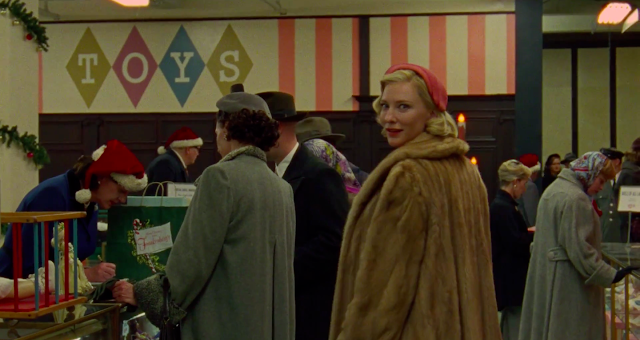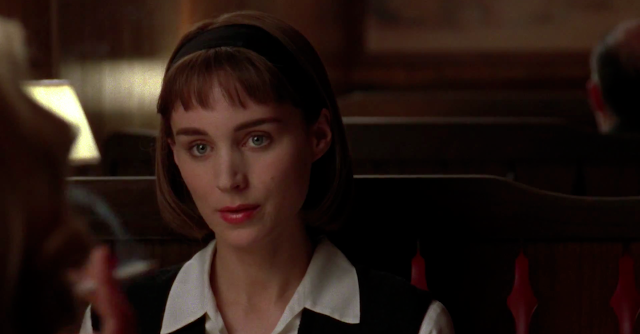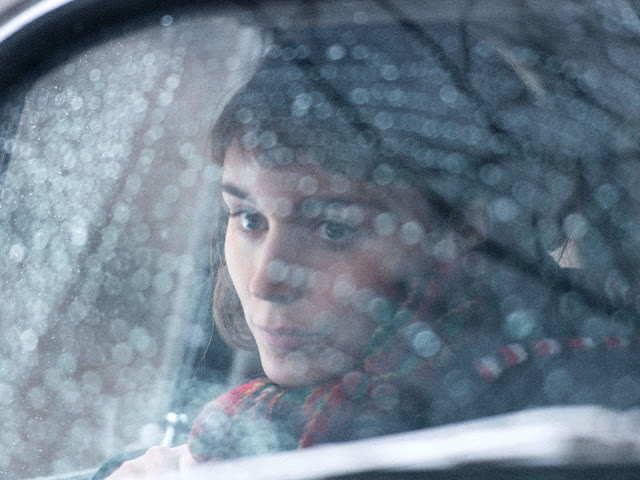Carol is the new film from Todd Haynes, though perhaps I should have preceded that factual nugget with a spoiler alert. Over the past two decades, in features such as Safe and Far from Heaven (both starring Julianne Moore) and in the HBO miniseries Mildred Pierce (with Kate Winslet), Haynes has established himself as America’s preeminent chronicler of the tragedy of feminine domesticity. He makes movies about putatively happy women who are nevertheless battered by normative prejudice and suffocated by societal constriction; his heroines, visibly content to onlookers, are secretly trapped by a lack of mobility and an absence of true freedom. Given this, you may anticipate—perhaps “dread” is the better word—that bad things will happen to the women in Carol. But while the characters here do endure their share of misfortune, what is stunning about this remarkable, enormously empathetic film is how life-affirming it is. A work of raw, pure emotion, Carol testifies to the power of human compassion, even as it also unflinchingly depicts human ugliness. It breaks your heart, and then, in startling fashion, it puts it back together again.
Based on a Patricia Highsmith novel called The Price of Salt, the movie’s title is somewhat deceptive. Yes, one of the principals is named Carol, and it seems only logical to christen the film after her, given that she is played with luminescent magnetism by Cate Blanchett. Yet the movie belongs equally to Therese Belivet (an extraordinary Rooney Mara), a twentysomething woman with a pageboy haircut and wide, hazel-green eyes. When we first take stock of Therese (the year is 1952), her life seems perfectly satisfactory. She has a steady if thankless job at a Manhattan department store, she has secured the romantic attentions of a good-looking man (Jake Lacy, from The Office and Obvious Child), and she has a fairly healthy social calendar, sneaking viewings of movies with friends in a projectionist booth and occasionally grabbing beers with them at a local bar. She appears to be on the fast track to a life of security, comfort, and contentment.
But Therese is interested in none of those things, and neither is Haynes. To him, they are false indicia of success that are incompatible with true passion, and he frames Therese as though she’s walking down a road toward the perdition of ordinariness. This is not to suggest that Therese is miserable, merely restless, striving to discover something of meaning in her life. When she is with other people, she seems to be going through the motions; the only time those eyes of hers light up is when she’s alone, peering at a child’s intricate train set or practicing her clandestine hobby of photography. Then, one day, she glances across the floor of that grand department store and locks eyes with an older woman in a plush fur coat.
This, of course, is Carol, who, in this pivotal and tantalizing early scene, returns Therese’s gaze with palpable interest. She strolls toward Therese’s desk, the two engage in a brief conversation—Therese recommends that Carol purchase that aforementioned train set for her four-year-old daughter, a suggestion that both surprises and satisfies Carol—and then Carol departs, only to inadvertently (intentionally?) leave behind her gloves. Therese, dutiful employee that she is, has no choice but to peek at Carol’s address on the order slip and mail them back to her. A few days later, she is surprised—and more than a little pleased—when she receives a phone call at work from Carol, who thanks her for returning the gloves and asks if they might have lunch.
Can you see where this is going? Maybe, though then again, maybe not. (Lest you think the movie is predictable, it delivers at least one shocking reveal.) In any event, it hardly matters. Carol is less about propelling its plot forward than about exploring the burgeoning relationship between its two leads, and it does with uncommon thoughtfulness and verisimilitude. Therese is understandably transfixed with Carol, who lives in a handsome home in New Jersey and who seems as worldly as Therese is naïve. But Carol is equally fascinated by Therese, seeing in her an unburdened young woman whose entire life is still stretched out in front of her. “What a strange girl you are,” Carol says of Therese, regarding those unblinking eyes with complimentary curiosity. “Flung out of space.”
As Carol and Therese spend more time together—Therese ventures to Carol’s house on Christmas, and the two eventually take a road trip that feels thrilling in its lack of destination—Carol grows richer and more heady, even as it also makes room for narrative complications. Primarily, these involve men, who serve not as romantic foils but as obstacles, as well as markers of male entitlement. Carol is currently divorcing her husband, Harge (Kyle Chandler), who demands full custody of their daughter and who is furious with his wife—not because he dislikes her, but because he cannot fathom why she no longer loves him, even though he has provided her with a life of means. The scenes between Carol and Harge, while convincing in their display of a fractured marriage, feel more mechanically plot-driven than the rest of the film, more didactic than organic. Less critical but more compelling are Therese’s dalliances with men. She deflects the amorous intentions of Dannie (John Magaro, recently seen in The Big Short), a writer who encourages her interest in photography, and she also frustrates her boyfriend, Richard (Lacy); when Therese doesn’t leap at Richard’s offer of a trip to France, he is utterly bewildered. His sense of bafflement is a proxy for the hidden chauvinism of the era, which Haynes posits as a time when men bestowed women with affection under the vulgar assumption that it would be reciprocated. (This is also articulated in the film’s brilliant flashback device, in which a man casually interrupts an encounter between Carol and Therese, oblivious to the torrent of emotion roiling between the two.)
This makes it easy to label Carol a feminist picture, but doing so unjustly politicizes a film that is wonderfully, breathtakingly intimate. In that, it makes a fine companion piece to this year’s Brooklyn, John Crowley’s marvelous account of an Irish immigrant tentatively settling into America; both movies are 1950s romances suffused with feeling and centering on strong, independent women. (Both also feature characters working in New York department stores.) But where Brooklyn is chiefly a coming-of-age tale—its love triangle, while pivotal to its plot, is secondary to its heroine’s personal maturation—Carol is a love story in the truest sense. It soars to its greatest heights when its two main characters are together, allowing us to observe the intoxicating process in which two people gradually fall in love. Rarely in cinema has the whispered declaration of “I love you” generated such a jolt of electricity. (Another phrase uttered in the film—the revolting term “morality clause”—similarly induces a blast of feeling, though it provokes vitriol rather than warmth.)
Carol also affords us the opportunity to watch two magnificent actresses. Blanchett is an emotional hurricane, freewheeling from ardent affection to volcanic rage and back, yet always maintaining an imperceptible degree of nuance in Carol’s breathlessness. But it is Mara who steadily anchors the film, silently imbuing Therese with an unnourished longing that is suddenly, exhilaratingly satisfied when Carol enters her life. Together, the two create a heartwarming and heartbreaking romance, an alchemy redolent with hope, love, and grief. Carol may be based on a novel, but it feels ideally suited to the screen, where the characters can look upon one another, and where you can see the desire and pain that floods their faces.
The screen is also the canvas where directors can paint, and here Haynes once again proves himself a master of cinematic form and language. Many period pieces carry the tasteful suggestion of being well-made, but Carol is more than just a superlative evocation of a bygone era—its superb technique is of a piece with its story, elevating its impact through clarity and precision. Shooting in 16-millimeter, Haynes’s longtime cinematographer Edward Lachman gorgeously evokes the dusky beauty of post-war New York, with a heavy layer of grain that makes you want to reach out and caress the frame. Sandy Powell’s costumes are ravishing (Carol’s furs could inspire a collective coronary at PETA’s offices), while Judy Becker’s production design is immaculate. And Carter Burwell’s score is one of his best, the piano and strings deftly quickening the movie’s emotional pulse without ever falling prey to showmanship. Again, it is important to recognize that these contributions are not discrete pieces of impressive craft; rather, they combine to serve Carol‘s story, and to intensify its power. Never is this more evident than in the film’s final scene, a wordless, heart-pounding moment of sublime choreography that is as suspenseful as any sequence I witnessed all year.
Of course, it is also just a scene about two people in a room together. But while Carol is largely uncomplicated, it is quite the opposite of mundane. It is instead an achingly simple movie about two people falling in love, yearning to be together while the cruel vagaries of the world conspire to keep them apart. And in its tender, beautiful simplicity, it is its own form of marvel—a miracle, flung out of space.
Jeremy Beck is the editor-in-chief of MovieManifesto. He watches more movies and television than he probably should.




